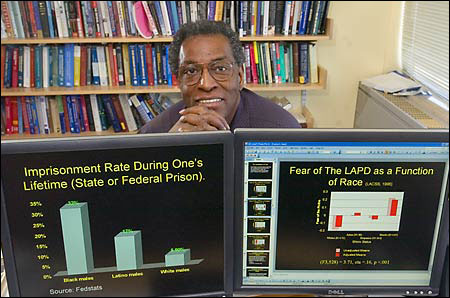Sidanius explores social division, power
Formulator of influential social theory looks at conflict

In Sweden, it was immigrant Finns who made up the underclass, Sidanius said. And it was while observing Swedish discrimination against the Finns that Sidanius began to think that racism isn’t uniquely American, as he had grown up believing, but rather an expression of a more universal human tendency toward group division and oppression.
“The stereotypes were very similar,” said Sidanius, who was named professor of psychology and of African and African-American studies in January. “They [the Finns] were perceived as lazy and dangerous and not wanting to work. I began to think there was something more interesting going on there.”
Those observations put Sidanius’ feet on a path that would lead him to develop an influential theory of social dominance that categorizes social hierarchy by age, sex, and group dominance, with the latter mainly played out between males of dominant and subdominant groups.
“Jim is without question one of the most distinguished social psychologists in the world who have an evolutionary perspective,” said Psychology Department Chairman Stephen Kosslyn, the John Lindsley Professor of Psychology. “He has developed a novel theory, which explains an enormous amount of different sorts of findings and makes new predictions, some of which are counterintuitive and have fascinating real-world implications.”
Sidanius said his theory, developed over the past 15 years, views society as a group-based hierarchy. Within the hierarchy are three major divisions. Age is the first one, with older individuals dominating younger ones. Sex is the second division, with males dominating females.
The third division has arbitrary boundaries, but sets a socially designated group at the top of the hierarchy with other groups below. Different societies establish those boundaries at different places. And, though race forms a common dividing line between groups, religion, nationality, ethnicity, and other differences can also serve to delineate hierarchies.
This third form of hierarchy is primarily expressed by in-group males against out-group males, Sidanius said, and can be expressed as xenophobia and racism.
“It’s an aggressive form of control, male on male,” Sidanius said. “Racism is an example that is primarily practiced by Group A males against Group B males.”
Various studies have borne this out, Sidanius said. Salary surveys show that African-American women make about the same as white women in the workforce, though less than white men. In contrast, white men earn substantially more than African-American men, even after controlling for factors such as specific job type, hours worked, and educational attainment. Similar disparities are expressed across the social spectrum, from prices paid for new cars to college participation to male representation in the prison population.
“We argue that this [racism] is just a special case of another phenomenon. Racism is just another form of intergroup conflict,” Sidanius said.
Sidanius comes to Harvard from the University of California, Los Angeles, where he has been on the faculty since 1988. Before that, Sidanius held positions at the University of Texas, Austin, Carnegie-Mellon University, Princeton University, New York University, and the University of Stockholm. He received his doctorate in psychology at the University of Stockholm in 1977 and a bachelor’s degree in psychology from the City College of the City University of New York in 1968.
He has written two books and edited a third and is the author of more than 100 articles in peer-reviewed journals.
Sidanius said he recalls always being interested in psychology. His interest in politics and society also began early. He remembers protesting at the United Nations as a 14-year-old New York high school student for the release of Patrice Lumumba, the Congolese leader slain in the early years of the Congo’s independence from Belgium.
Sidanius was initially interested in clinical psychology and, after graduating from the City University of New York, worked counseling black and Hispanic youth. The deaths of civil rights leaders and disillusionment with the United States led him to Sweden in the early 1970s.
Sidanius’ theory holds bad news for those who dream of one day achieving a truly egalitarian society. Whenever the old structures are overthrown, he said, the natural human tendency to draw lines between groups and establish a societal pecking order kicks into action. The American Revolution, for example, overthrew the idea of an aristocracy that ruled over the lower classes by birthright, but replaced it with a hierarchy based on race, ethnicity, and economic class.
“There’s no society we’ve been able to observe without these hierarchically organized categories,” Sidanius said. “Even in a hunter-gatherer society, while there are few, if any, hierarchically ordered group differences among males, males still tend to be dominant over females. We argue that [true equality] is probably not ever going to happen.”
Related links:




